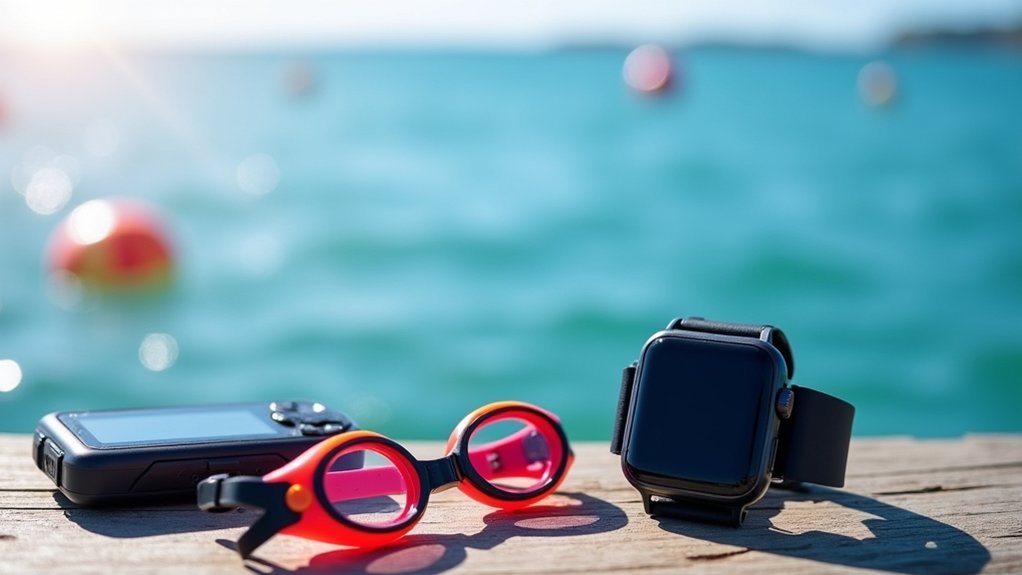To improve your open water GPS tracking, position your device under a swim cap or in a floating dry bag to keep it close to the water’s surface. Optimize your GPS settings by enabling multiple satellite systems and allowing at least 30 seconds for a stable satellite lock before swimming. Choose equipment specifically designed for swim tracking, like the Garmin Swim 2, with real-time feedback features. These adjustments will transform your tracking accuracy and enhance your training insights.
Position Your Device for Maximum Signal Reception

When swimming in open water, your GPS device’s placement can make the difference between accurate tracking and lost data. For best results, position your device under a swim cap to keep it closer to the water’s surface where signals are stronger.
Consider using a dry bag that floats if you need maximum accuracy. While arm positioning (left versus right) generally has minimal impact on signal quality, your swimming technique does matter. Some strokes naturally keep your device more frequently above water, improving tracking.
For ultimate precision, try a floating dry bag and focus on stroke technique rather than which arm wears your device.
Choose devices that support multiple satellite systems like GPS, GLONASS, and Galileo for better coverage. Wait a minute after GPS signal acquisition before entering the water to ensure optimal triangulation.
Be aware that environmental factors such as waves, wind, and weather conditions can interfere with signals. In challenging conditions, adjust your swim technique to make sure your device breaks the surface regularly.
Optimize GPS Settings Before Your Swim
Beyond proper device placement, your GPS settings play a key role in capturing accurate swim data. Before hitting the water, sync your watch with your smartphone to load the latest satellite data and update firmware to incorporate GPS accuracy improvements.
Enable multiple satellite systems (GPS, GLONASS, Galileo) rather than using just one. These additional constellations provide better coverage and improve tracking reliability. Avoid power-saving GPS modes like UltraTrac that sacrifice accuracy.
Allow your device to acquire a stable satellite lock for at least 30 seconds before starting your swim. Stand in an open area with clear sky visibility during this process. Check your signal strength or satellite count to confirm readiness. It’s recommended to wait for GPS signal before entering the water for better accuracy of distance tracking.
Reset GPS data before important swims to clear cached information and improve initial satellite acquisition.
Choose the Right Equipment for Open Water Tracking

Selecting the ideal GPS device can make the difference between accurately tracking your swim and ending up with unreliable data. When evaluating options, prioritize accuracy, size, and durability in open water conditions.
Look for devices that offer:
- Proven GPS accuracy like the Garmin Swim 2, which provides reliable distance and pace measurements
- Real-time feedback features such as the Marlin’s audio cues or FORM’s visual navigation system
- Lightweight, drag-minimizing design to prevent interference with your swimming mechanics
- Compatibility with your existing gear ecosystem, ensuring data syncs seamlessly with your preferred analysis apps
Don’t overlook waterproof ratings, especially for rough water conditions.
The right equipment won’t just track your swim—it’ll help improve your performance through actionable insights.
Allow 10-15 minutes for proper GPS signal acquisition before entering the water to ensure maximum tracking accuracy.
Frequently Asked Questions
How Does Water Temperature Affect GPS Tracking Accuracy?
Water temperature doesn’t directly affect GPS signals, but it impacts your device’s battery performance, can cause thermal expansion of components, and may accelerate corrosion in saltwater, all potentially reducing tracking accuracy.
Can Weather Conditions Impact GPS Signal Quality?
Yes, weather conditions greatly impact your GPS signal quality. Heavy rain, dense clouds, and storms can attenuate signals, while ionospheric disturbances and geomagnetic storms may prevent your receiver from locking onto satellites effectively.
How Often Should I Update My Device’s Firmware?
You should update your device’s firmware every 3-4 months. This guarantees you’ll have the latest features, bug fixes, and performance improvements. Don’t forget to check manually if automatic updates aren’t enabled on your device.
Why Does My GPS Track Show Zigzag Patterns?
Your GPS track shows zigzag patterns due to signal bounce, poor satellite connections, multipath interference from reflections, or device limitations. These errors make your recorded path appear jagged rather than smooth when tracking your movement.
Does Swimming Style Affect GPS Tracking Performance?
Yes, your swimming style affects GPS tracking considerably. Different strokes create varied arm movements and water disturbance. Freestyle with consistent pacing and minimal zigzagging will give you the most accurate GPS tracking results.
In Summary
You’re now equipped to tackle open water GPS tracking like a pro. By positioning your device strategically, optimizing your settings before entering the water, and selecting appropriate equipment for your swims, you’ll capture more accurate data with fewer disruptions. Remember, it’s not just about recording your route—it’s about improving your performance through reliable tracking. Give these tips a try on your next open water adventure.





Leave a Reply